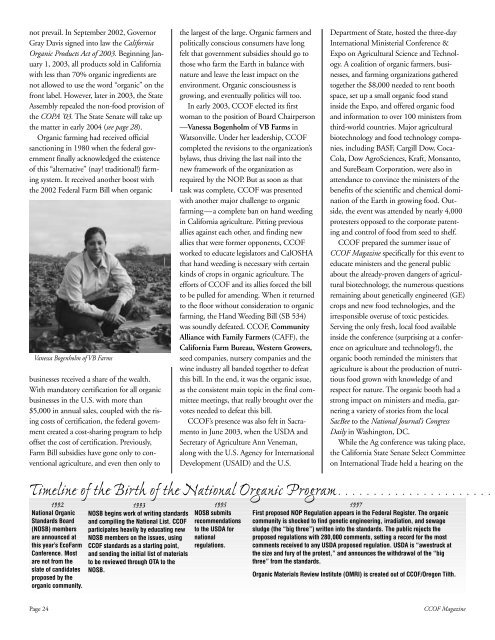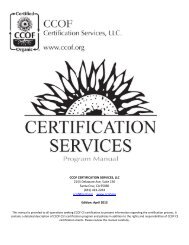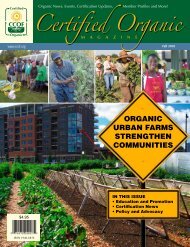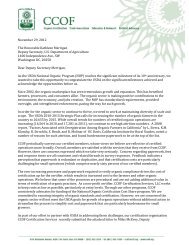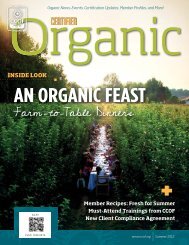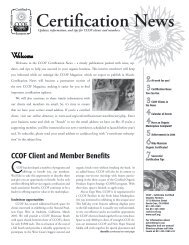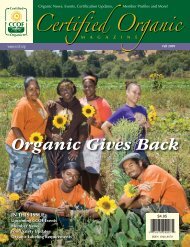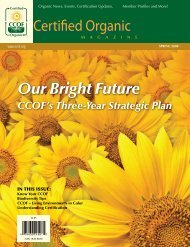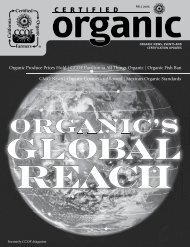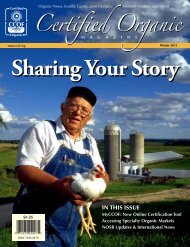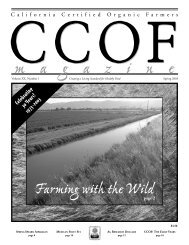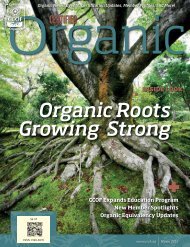Consolidation in Organic Agriculture - CCOF
Consolidation in Organic Agriculture - CCOF
Consolidation in Organic Agriculture - CCOF
You also want an ePaper? Increase the reach of your titles
YUMPU automatically turns print PDFs into web optimized ePapers that Google loves.
not prevail. In September 2002, GovernorGray Davis signed <strong>in</strong>to law the California<strong>Organic</strong> Products Act of 2003. Beg<strong>in</strong>n<strong>in</strong>g January1, 2003, all products sold <strong>in</strong> Californiawith less than 70% organic <strong>in</strong>gredients arenot allowed to use the word “organic” on thefront label. However, later <strong>in</strong> 2003, the StateAssembly repealed the non-food provision ofthe COPA ’03. The State Senate will take upthe matter <strong>in</strong> early 2004 (see page 28).<strong>Organic</strong> farm<strong>in</strong>g had received officialsanction<strong>in</strong>g <strong>in</strong> 1980 when the federal governmentf<strong>in</strong>ally acknowledged the existenceof this “alternative” (nay! traditional!) farm<strong>in</strong>gsystem. It received another boost withthe 2002 Federal Farm Bill when organicVanessa Bogenholm of VB Farmsbus<strong>in</strong>esses received a share of the wealth.With mandatory certification for all organicbus<strong>in</strong>esses <strong>in</strong> the U.S. with more than$5,000 <strong>in</strong> annual sales, coupled with the ris<strong>in</strong>gcosts of certification, the federal governmentcreated a cost-shar<strong>in</strong>g program to helpoffset the cost of certification. Previously,Farm Bill subsidies have gone only to conventionalagriculture, and even then only tothe largest of the large. <strong>Organic</strong> farmers andpolitically conscious consumers have longfelt that government subsidies should go tothose who farm the Earth <strong>in</strong> balance withnature and leave the least impact on theenvironment. <strong>Organic</strong> consciousness isgrow<strong>in</strong>g, and eventually politics will too.In early 2003, <strong>CCOF</strong> elected its firstwoman to the position of Board Chairperson—Vanessa Bogenholm of VB Farms <strong>in</strong>Watsonville. Under her leadership, <strong>CCOF</strong>completed the revisions to the organization’sbylaws, thus driv<strong>in</strong>g the last nail <strong>in</strong>to thenew framework of the organization asrequired by the NOP. But as soon as thattask was complete, <strong>CCOF</strong> was presentedwith another major challenge to organicfarm<strong>in</strong>g—a complete ban on hand weed<strong>in</strong>g<strong>in</strong> California agriculture. Pitt<strong>in</strong>g previousallies aga<strong>in</strong>st each other, and f<strong>in</strong>d<strong>in</strong>g newallies that were former opponents, <strong>CCOF</strong>worked to educate legislators and CalOSHAthat hand weed<strong>in</strong>g is necessary with certa<strong>in</strong>k<strong>in</strong>ds of crops <strong>in</strong> organic agriculture. Theefforts of <strong>CCOF</strong> and its allies forced the billto be pulled for amend<strong>in</strong>g. When it returnedto the floor without consideration to organicfarm<strong>in</strong>g, the Hand Weed<strong>in</strong>g Bill (SB 534)was soundly defeated. <strong>CCOF</strong>, CommunityAlliance with Family Farmers (CAFF), theCalifornia Farm Bureau, Western Growers,seed companies, nursery companies and thew<strong>in</strong>e <strong>in</strong>dustry all banded together to defeatthis bill. In the end, it was the organic issue,as the consistent ma<strong>in</strong> topic <strong>in</strong> the f<strong>in</strong>al committeemeet<strong>in</strong>gs, that really brought over thevotes needed to defeat this bill.<strong>CCOF</strong>’s presence was also felt <strong>in</strong> Sacramento<strong>in</strong> June 2003, when the USDA andSecretary of <strong>Agriculture</strong> Ann Veneman,along with the U.S. Agency for InternationalDevelopment (USAID) and the U.S.Department of State, hosted the three-dayInternational M<strong>in</strong>isterial Conference &Expo on Agricultural Science and Technology.A coalition of organic farmers, bus<strong>in</strong>esses,and farm<strong>in</strong>g organizations gatheredtogether the $8,000 needed to rent boothspace, set up a small organic food stand<strong>in</strong>side the Expo, and offered organic foodand <strong>in</strong>formation to over 100 m<strong>in</strong>isters fromthird-world countries. Major agriculturalbiotechnology and food technology companies,<strong>in</strong>clud<strong>in</strong>g BASF, Cargill Dow, Coca-Cola, Dow AgroSciences, Kraft, Monsanto,and SureBeam Corporation, were also <strong>in</strong>attendance to conv<strong>in</strong>ce the m<strong>in</strong>isters of thebenefits of the scientific and chemical dom<strong>in</strong>ationof the Earth <strong>in</strong> grow<strong>in</strong>g food. Outside,the event was attended by nearly 4,000protesters opposed to the corporate patent<strong>in</strong>gand control of food from seed to shelf.<strong>CCOF</strong> prepared the summer issue of<strong>CCOF</strong> Magaz<strong>in</strong>e specifically for this event toeducate m<strong>in</strong>isters and the general publicabout the already-proven dangers of agriculturalbiotechnology, the numerous questionsrema<strong>in</strong><strong>in</strong>g about genetically eng<strong>in</strong>eered (GE)crops and new food technologies, and theirresponsible overuse of toxic pesticides.Serv<strong>in</strong>g the only fresh, local food available<strong>in</strong>side the conference (surpris<strong>in</strong>g at a conferenceon agriculture and technology!), theorganic booth rem<strong>in</strong>ded the m<strong>in</strong>isters thatagriculture is about the production of nutritiousfood grown with knowledge of andrespect for nature. The organic booth had astrong impact on m<strong>in</strong>isters and media, garner<strong>in</strong>ga variety of stories from the localSacBee to the National Journal’s CongressDaily <strong>in</strong> Wash<strong>in</strong>gton, DC.While the Ag conference was tak<strong>in</strong>g place,the California State Senate Select Committeeon International Trade held a hear<strong>in</strong>g on theTimel<strong>in</strong>e of the Birth of the National <strong>Organic</strong> Program. . . . . . . . . . . . . . . . . . . . . .1992National <strong>Organic</strong>Standards Board(NOSB) membersare announced atthis year’s EcoFarmConference. Mostare not from theslate of candidatesproposed by theorganic community.1993NOSB beg<strong>in</strong>s work of writ<strong>in</strong>g standardsand compil<strong>in</strong>g the National List. <strong>CCOF</strong>participates heavily by educat<strong>in</strong>g newNOSB members on the issues, us<strong>in</strong>g<strong>CCOF</strong> standards as a start<strong>in</strong>g po<strong>in</strong>t,and send<strong>in</strong>g the <strong>in</strong>itial list of materialsto be reviewed through OTA to theNOSB.1995NOSB submitsrecommendationsto the USDA fornationalregulations.1997First proposed NOP Regulation appears <strong>in</strong> the Federal Register. The organiccommunity is shocked to f<strong>in</strong>d genetic eng<strong>in</strong>eer<strong>in</strong>g, irradiation, and sewagesludge (the “big three”) written <strong>in</strong>to the standards. The public rejects theproposed regulations with 280,000 comments, sett<strong>in</strong>g a record for the mostcomments received to any USDA proposed regulation. USDA is “awestruck atthe size and fury of the protest,” and announces the withdrawal of the “bigthree” from the standards.<strong>Organic</strong> Materials Review Institute (OMRI) is created out of <strong>CCOF</strong>/Oregon Tilth.Page 24<strong>CCOF</strong> Magaz<strong>in</strong>e


